
Alternative splicing, or alternative RNA splicing, or differential splicing, is an alternative splicing process during gene expression that allows a single gene to produce different splice variants. For example, some exons of a gene may be included within or excluded from the final RNA product of the gene. This means the exons are joined in different combinations, leading to different splice variants. In the case of protein-coding genes, the proteins translated from these splice variants may contain differences in their amino acid sequence and in their biological functions.

SR proteins are a conserved family of proteins involved in RNA splicing. SR proteins are named because they contain a protein domain with long repeats of serine and arginine amino acid residues, whose standard abbreviations are "S" and "R" respectively. SR proteins are ~200-600 amino acids in length and composed of two domains, the RNA recognition motif (RRM) region and the RS domain. SR proteins are more commonly found in the nucleus than the cytoplasm, but several SR proteins are known to shuttle between the nucleus and the cytoplasm.
RNA-binding proteins are proteins that bind to the double or single stranded RNA in cells and participate in forming ribonucleoprotein complexes. RBPs contain various structural motifs, such as RNA recognition motif (RRM), dsRNA binding domain, zinc finger and others. They are cytoplasmic and nuclear proteins. However, since most mature RNA is exported from the nucleus relatively quickly, most RBPs in the nucleus exist as complexes of protein and pre-mRNA called heterogeneous ribonucleoprotein particles (hnRNPs). RBPs have crucial roles in various cellular processes such as: cellular function, transport and localization. They especially play a major role in post-transcriptional control of RNAs, such as: splicing, polyadenylation, mRNA stabilization, mRNA localization and translation. Eukaryotic cells express diverse RBPs with unique RNA-binding activity and protein–protein interaction. According to the Eukaryotic RBP Database (EuRBPDB), there are 2961 genes encoding RBPs in humans. During evolution, the diversity of RBPs greatly increased with the increase in the number of introns. Diversity enabled eukaryotic cells to utilize RNA exons in various arrangements, giving rise to a unique RNP (ribonucleoprotein) for each RNA. Although RBPs have a crucial role in post-transcriptional regulation in gene expression, relatively few RBPs have been studied systematically.It has now become clear that RNA–RBP interactions play important roles in many biological processes among organisms.

ELAV-like protein 1 or HuR is a protein that in humans is encoded by the ELAVL1 gene.

Deleted in azoospermia 1, also known as DAZ1, is a protein which in humans is encoded by the DAZ1 gene.

Folate receptor 1 is a protein that in humans is encoded by the FOLR1 gene.
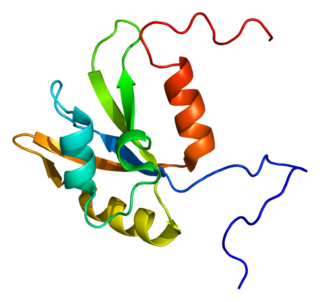
Heterogeneous nuclear ribonucleoprotein F is a protein that in humans is encoded by the HNRNPF gene.

CUGBP, Elav-like family member 2, also known as Etr-3 is a protein that in humans is encoded by the CELF2 gene.
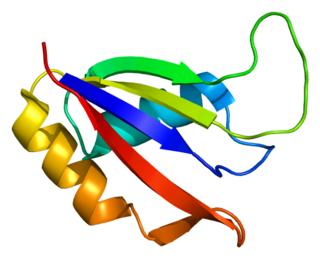
Aly/REF export factor, also known as THO complex subunit 4 is a protein that in humans is encoded by the ALYREF gene.

RNA-binding motif 10 is a protein that is encoded by the RBM10 gene. This gene maps on the X chromosome at Xp11.23 in humans. RBM10 is a regulator of alternative splicing. Alternative splicing is a process associated with gene expression to produce multiple protein isoforms from a single gene, thereby creating functional diversity and cellular complexity. RBM10 influences the expression of many genes, participating in various cellular processes and pathways such as cell proliferation and apoptosis. Its mutations are associated with various human diseases such as TARP syndrome, an X-linked congenital disorder in males resulting in pre‐ or postnatal lethality, and various cancers in adults.
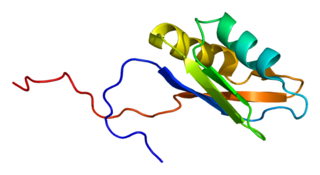
RNA-binding protein 4 is a protein that in humans is encoded by the RBM4 gene.

Serine/threonine-protein kinase PAK 5 is an enzyme that in humans is encoded by the PAK5 gene.
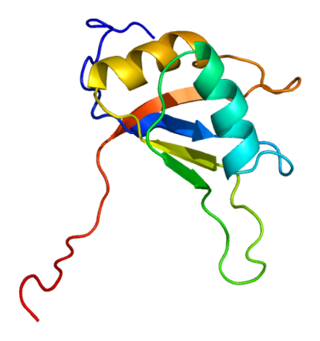
Cold-inducible RNA-binding protein is a protein that in humans is encoded by the CIRBP gene. The cold inducible RNA-binding protein CIRBP plays a critical role in controlling the cellular response upon confronting a variety of cellular stresses, including short wavelength ultraviolet light, hypoxia, and hypothermia.

Heterogeneous nuclear ribonucleoprotein A0 is a protein that in humans is encoded by the HNRNPA0 gene.

A-kinase anchor protein 4 is a scaffold protein that in humans is encoded by the AKAP4 gene. It involves in the intracellular signalling of protein kinase -A. AKAP4 is called as cancer /testis antigen (CTA), it belongs to a class of tumour linked antigens categories by high expression in germ cells and cancer than normal tissues. AKAP4 is not normally expressed in mRNA and protein level in MM cell line.
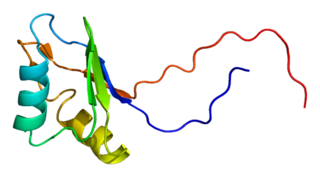
Insulin-like growth factor 2 mRNA-binding protein 2 is a protein that in humans is encoded by the IGF2BP2 gene.
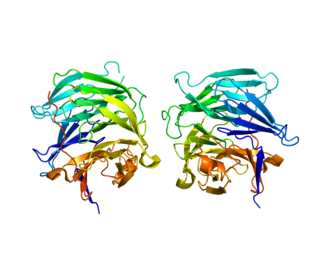
Regucalcin is a protein that in humans is encoded by the RGN gene

Zinc finger CCHC-type containing 18 (ZCCHC18) is a protein that in humans is encoded by ZCCHC18 gene. It is also known as Smad-interacting zinc finger protein 2 (SIZN2), para-neoplastic Ma antigen family member 7b (PNMA7B), and LOC644353. Other names such as zinc finger, CCHC domain containing 12 pseudogene 1, P0CG32, ZCC18_HUMAN had been used to describe this protein.
Small nucleolar RNA host gene 1 is a non-protein coding RNA that in humans is encoded by the SNHG1 gene.
The DAZprotein family is a group of three highly conserved RNA-binding proteins that are important in gametogenesis and meiosis. Therefore, mutations in the genes that encode for the DAZ proteins can have detrimental consequences for fertility.


















